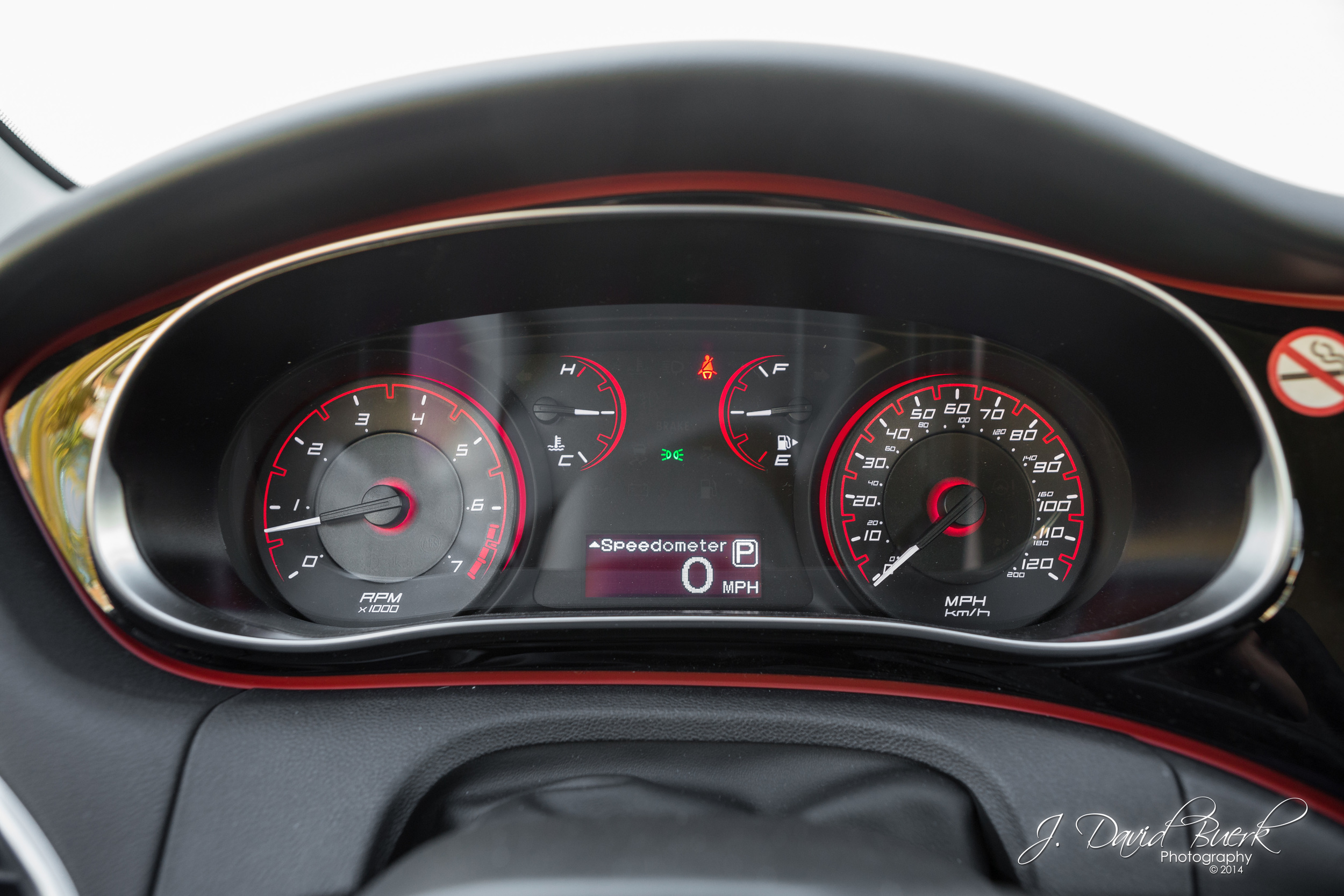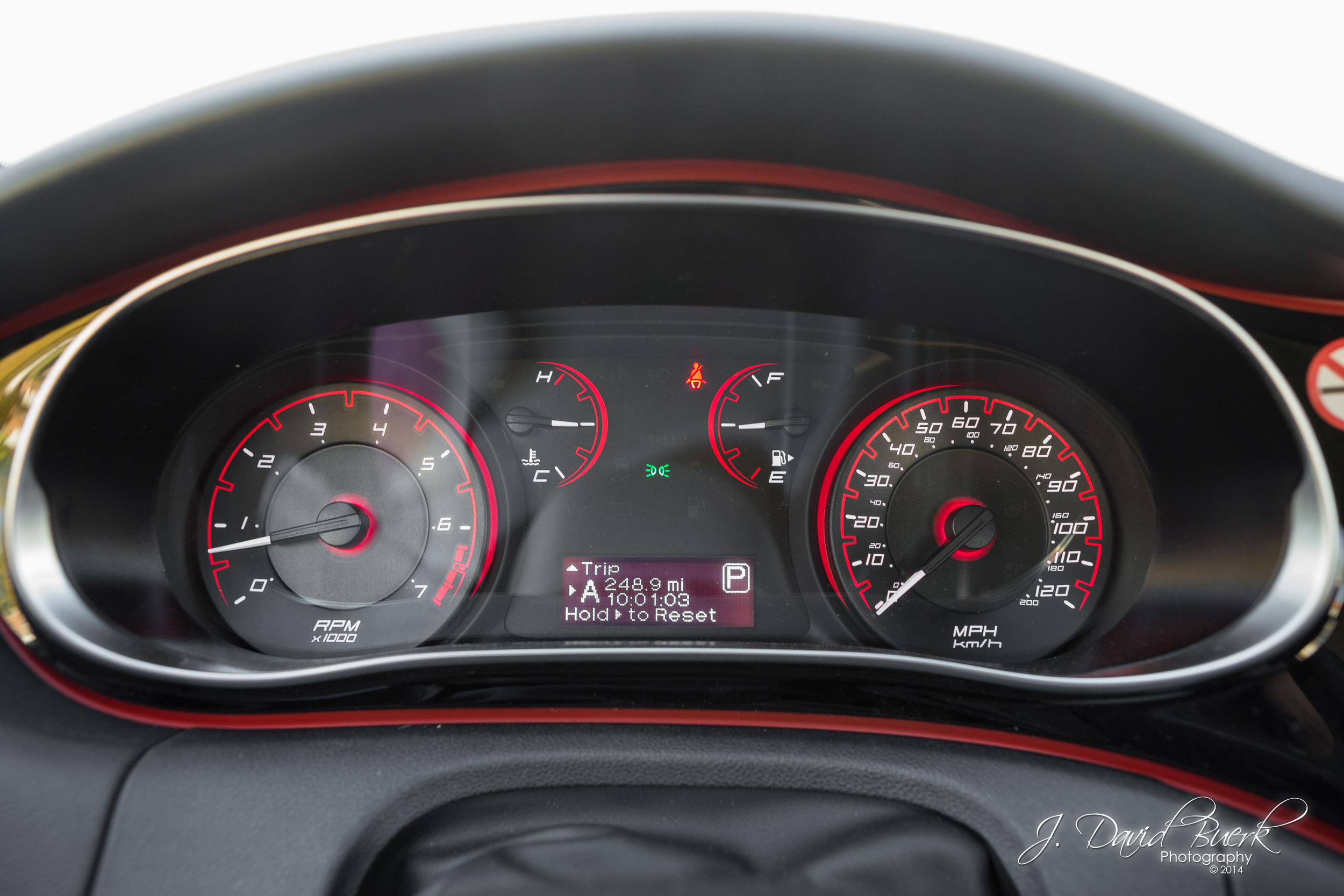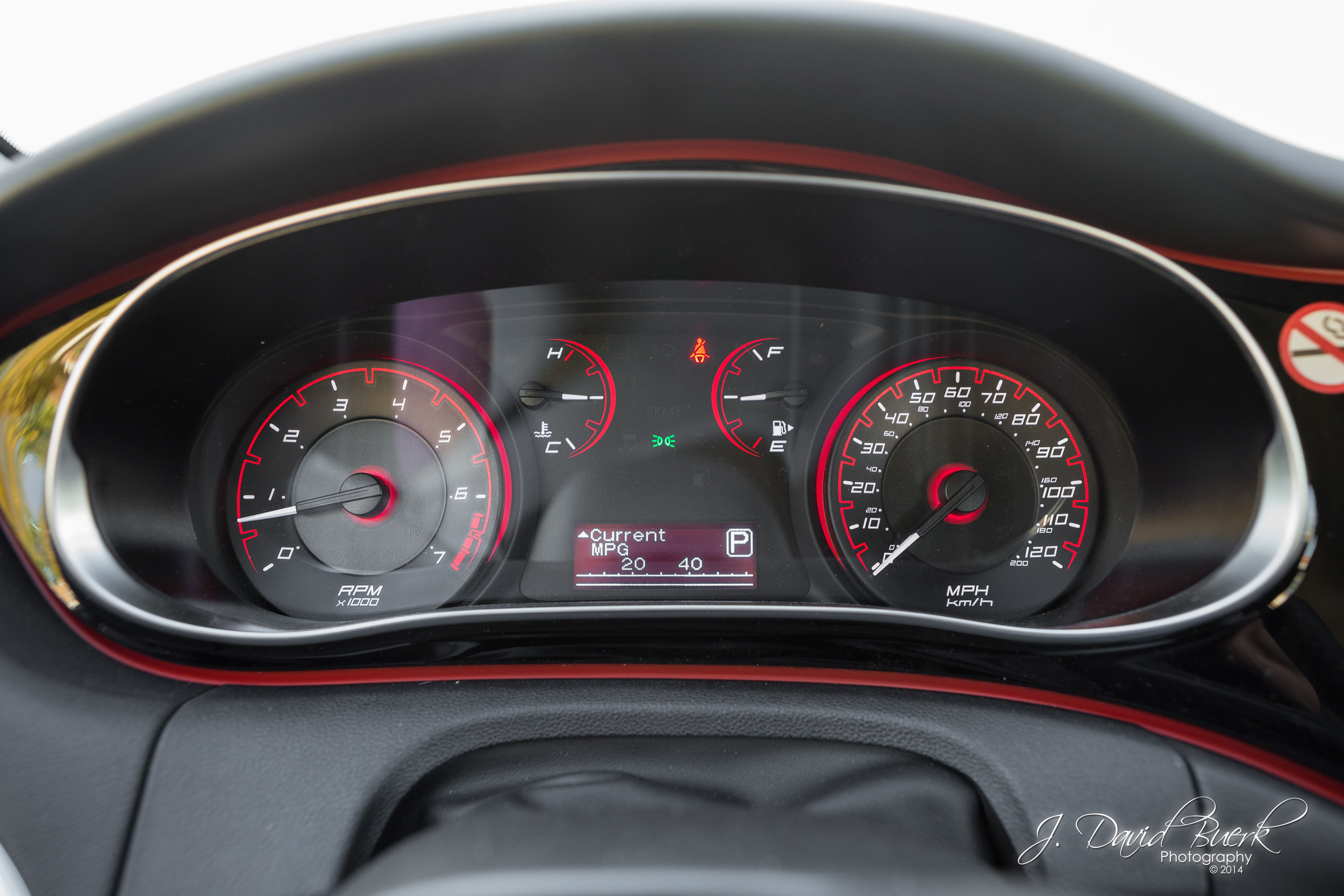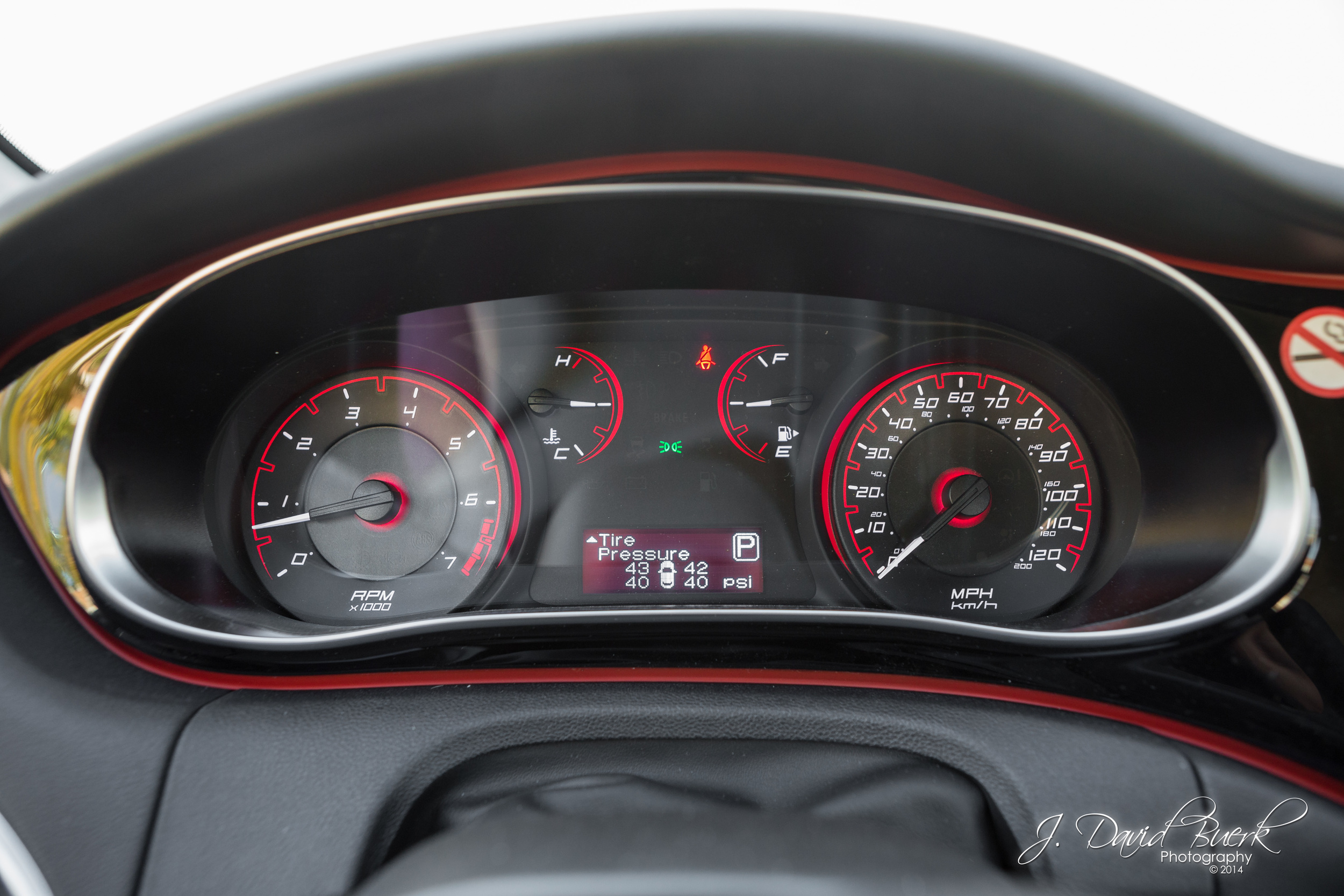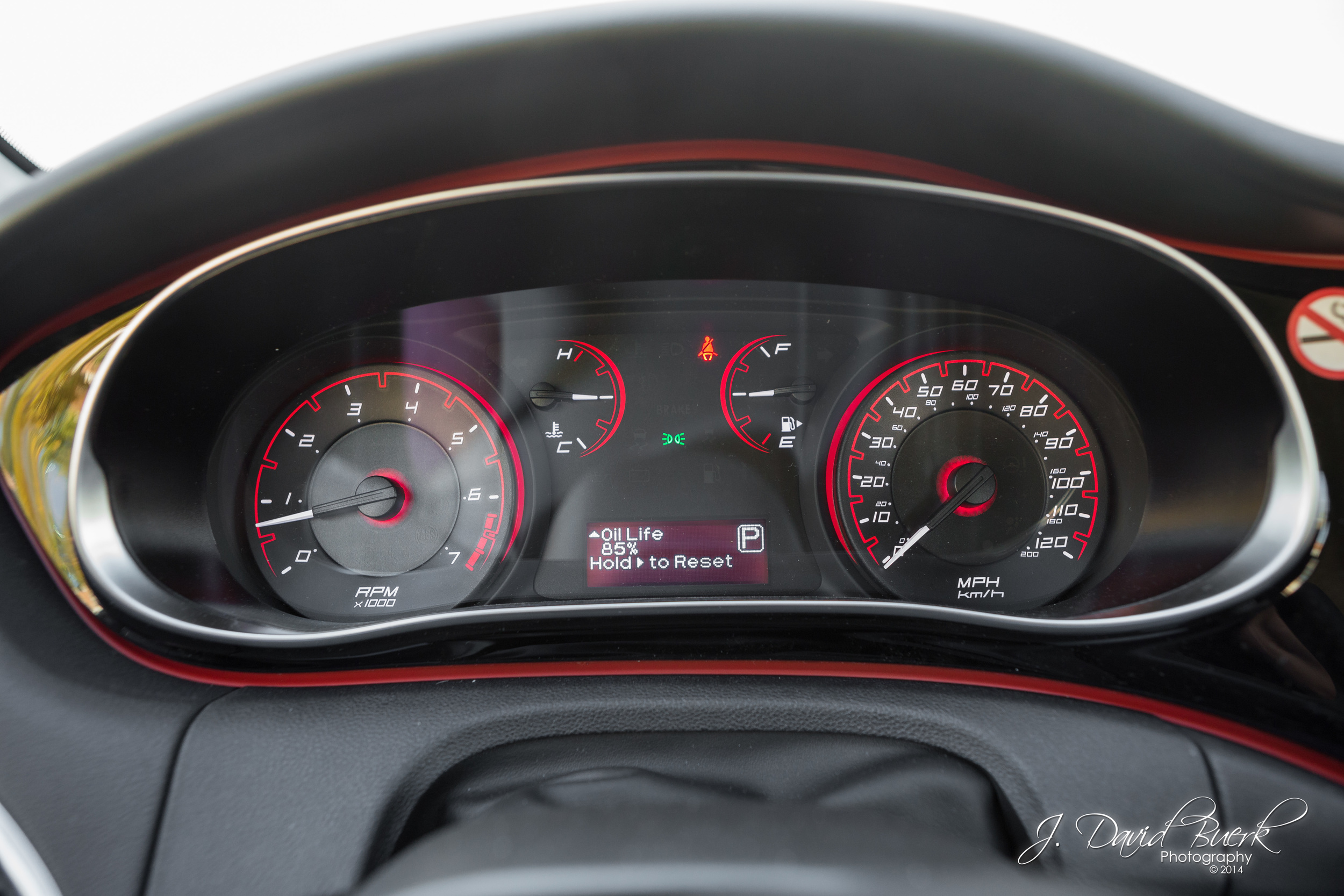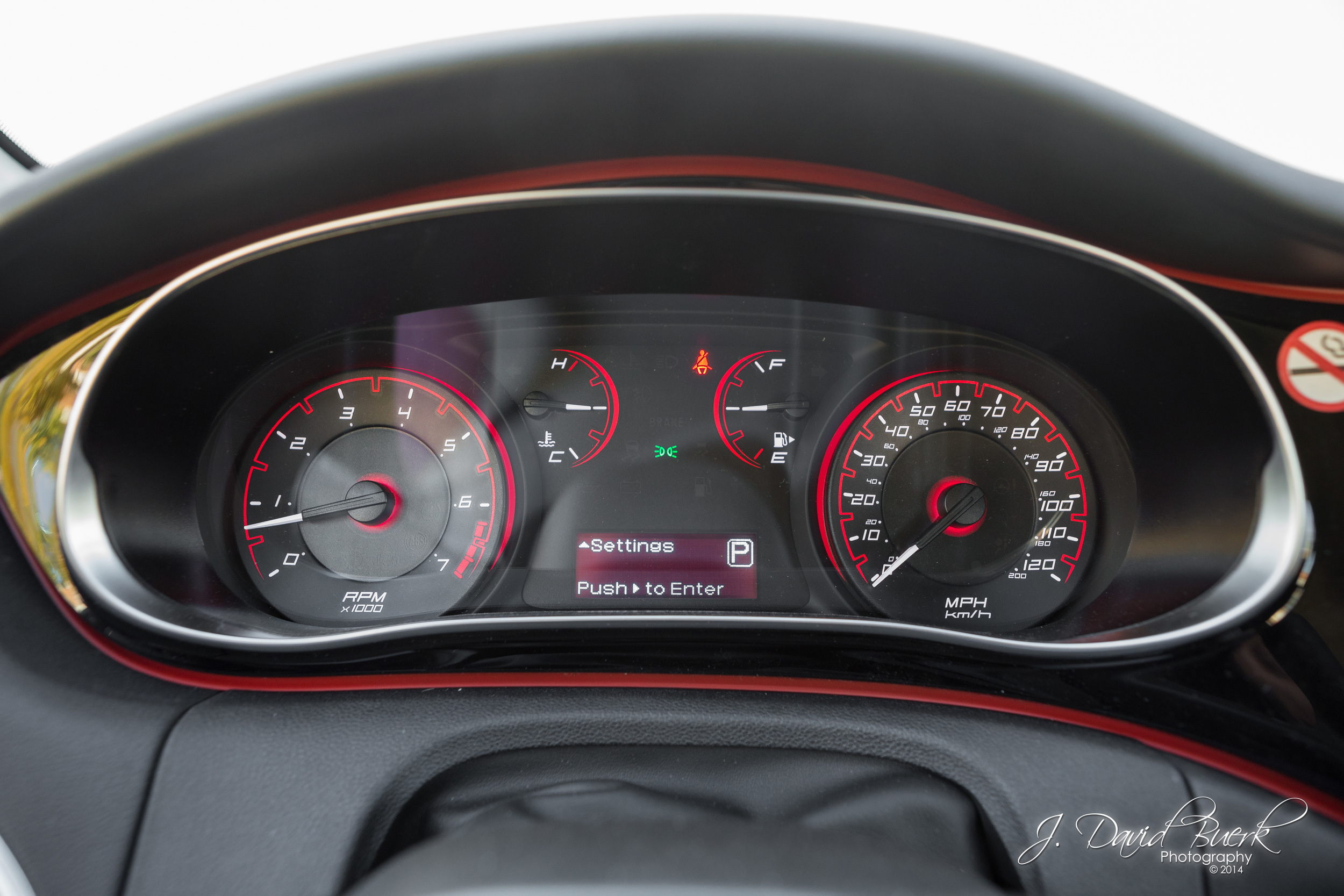On a recent trip to St. Louis, I spent two weeks with a brand new 2015 Dodge Dart SXT. Think the Dart is just a sexy Neon? Think again.
My rental Dart had only a couple hundred miles on the clock when it was given to me - I was only the second person to rent this car. This Dart was a 2015 SXT in True Blue Pearl Coat equipped with the 2.4L I-4 mated to a 6-Speed Automatic transmission with AutoStick, and no other options beyond a spare tire; MSRP is ~$19,890.
Exterior: 7 / 10
I’ll reiterate that this was a rental car with not much more than standard options. The Dodge Dart does have a number of appearance packages available which provide a more aero-aggressive styling, larger rims, dual exhaust with chrome tips, and a few other stylistic options. This Dart had none of these upgrades.
That said, I have always been a big fan of the modern Dart’s looks. The paint was a deep navy blue with slight metallic look (True Blue Pearl Coat), with color matched side mirrors standard. The classic Dodge crosshair grille is a piano black plastic that fits the nature of the car; anything else would be out of place - chrome or some silver / grey color would bring back sour memories of the Avenger, and a flat / matte black would look really cheap. The piano black is surely the best choice. Thin chrome strips adorn the fog light covers; there is a strip of chrome on the inside of the crosshair grille, but it is darker (more like a gunmetal) and hardly noticeable.
And those headlights; I’ve always loved the mean headlight design, with deep orange “undercover” feeling parking lights - the combination really makes the car look as though it is a bulldog creeping up to pounce and attack, only enhanced by the side lines to the rear, giving the car a hunched down appearance.
The rear end has always needed some refinement in my opinion. The taillights are perfect; a wonderful compliment to the Dart’s older brother, the Charger with its bright, grown up taillight. Likewise, the trunk and decklid is well done, with appropriate shaping and ducktail spoiler-like flaring. My complaint with the rear styling is the bubble-butt feel - the quarterpanels’ bottom corners are just too rounded and shaved for my taste. I realize that the Dart is more rounded than the boxier Charger, but I feel design could have reached a happy medium in this area, making edges slightly sharper for a more aggressive look.
Dart and friends at Starbucks.
Additionally, the rear sports a very cheap matte plastic underneath the license plate. Surely this is meant to be easily replaced by taking the brunt of your basic parking lot, shopping cart, and bollard dings, but everyone knows this material is a scratch and mar magnet. The slightest scrape and the plastic turns white, or permanently takes on invading paint colors. Left out in the sun, this plastic turns light grey in just a few years. Over time, this will be the Dart’s fatal flaw in its exterior.
The rims on this Dart were the basic 16" painted aluminum 5-spokes. They look fine, but of course the upgraded 17” or 18” rims would fill the wheel wells more appropriately. Black painted rims offer a moody, aggressive attitude, however I’d like to see the addition of a 17” chrome rim option that I think would also look great on this car.
Overall, the Dart’s reimagined form is well done, but could use some tweaking in a facelift to really set it apart and even out the quality level among its components.
Interior: 7 / 10
Sitting down in the Dart was comfortable, and the car is easy to enter and exit. Cloth mesh seats are supportive and well designed. I am happy to report that there is no annoying knap. The drivers seat was adjustable 6 ways manually, plus a perfectly placed headrest with standard height adjustment (no tilt adjustment, but I found the placement just right - something I am very picky about). The Dart has optional bun warmers - this one did not have them equipped.
The steering wheel was 4 way adjustable, and had now standard controls which were easy to find and use. The dash display had 7 screens which included Speedometer, Trip A & B, Instant MPG, Tire Pressure, Oil Life, Settings (Push to Enter), and Outdoor Temperature / Odometer. The dash is brightly lit for easy visibility, but not too bright, or distracting / painful to look at. The red dash surround does NOT illuminate.
Shifting was smooth with the firm and convenient shift knob. Using the AutoStick was a breeze, and I was very pleased to see that pulling aft upshifted and pushing fore downshifted.
Plenty of storage is provided between the tray, which easily held my wallet and bluetooth, cupholders, and under-armrest storage bin, which also contained a power port and the AUX stereo connection.
The cupholders worked well, gripping drinks with rubberized bubbles along the outside. Feeling these bubbles, however, indicate to me that after a few years of use, the rubberized plastic they are made from will surely crack and gradually deteriorate, particularly with prolonged heat and sun exposure.
I was shocked by how cavernous the glovebox was. In the front tray I was able to place my iPad Air, plugged in, and easily close the glovebox. Behind this front tray is the bottomless abyss - a storage hangar for your gloves, and probably an entire laptop if you really wanted. I still can’t get over how large this glovebox was.
The rear view mirror contains the microphone for UConnect, and the largest safety concern I had with the car: THIS CAR HAS A HUGE REAR BLIND SPOT. It could be a lot worse, but I’ve driven a lot better. The rear view mirror was manually dimming.
Sun visors had small, illuminated mirrors, and a surprise! I didn’t expect it, but these visors also extended out on their arms! Even in the retracted position, however, there was not enough headroom to avoid hitting oneself in the head when rotating the visor to the side window. I’m not super tall at 5’8” either.
The door panel held the usual controls. The only thing I found odd was that the mirror Left / Right selector had no off position, meaning if you bumped the 4-way pad, you're guaranteed to move one of your mirrors.
Honestly biggest interior complaint was the seemingly thoughtless placement of the trunk release. I’m sure with extended ownership it becomes easier, but in the two weeks I had the car, I struggled to find that little button every single day. It sounds silly as I write this, but this truly drove be insane to the point that I usually just resorted to hitting the FOB's button.
The back seat was also comfortable, and surprisingly roomy, although I never rode in the back seat.
Rear seats fold down to allow extra cargo storage, and the center armrest features a passthrough for smaller elongated items. The rear armrest also contains a storage tray and two cupholders equivalent but shallower than the front’s.
Each rear seat also had the compact headrests we have all come to know.
Trunk space was bountiful for a compact car, and a temp tire and changing kit was nestled underneath.
Dovetailing with the exterior, the trunk does not have any handles or straps to grab onto when closing - for car guys, this is huge; it means you have no choice but to smudge your paint or leave dusty imprints on the exterior of your car. This is such a simple design element; how was this overlooked?
When opening the trunk, it pops open about a foot. Some may like this as it prevents your stuff from being exposed to rain and nosy peeps, while others may want the quick access of a trunk that opens all the way - I like it as-is.
Acceleration: 8 / 10
SXT Darts have the largest engine option of three; the 2.4 L I4 Tigershark MultiAir 2 which outputs the most power, at 184HP, but falls to second in terms of torque, at 171 ft-lbs.
Make no mistake; this isn’t a super fast car, but it certainly feels it, and definitely sounds fast. At idle, the single exhaust SXT is near silent, but blipping the throttle, it extorts a loud, buzzing, belch.
Impressively, some wheelspin was allowed, even with TCS engaged.
Manually selecting 1st gear and slowly cruising through neighborhood at just 10MPH gets you a mean enough exhaust note that will earn you dirty looks from onlookers; the type of glare that says, “Hey, I have kids that play on this street - slow down, asshole.” as you just stare back creeping along, your eyes saying, “Hey idiot, I’m going 15 under the limit - it sounds faster than it actually is. I'll keep off your lawn too."
Here you can get a sense of what the Dart SXT sounds like:
Please note that the video is NOT where I tested 0-60 times… but I did a few 0-60 runs with and without TCS. Online, you will find numbers anywhere from low 8s to high 9s for the SXT; my results were pretty much in the middle:
- 9.7s without TCS (wheelspin)
- 9.2s without TCS (feathered throttle)
- 9.0 with TCS
So, make of that what you will.
Also, here are two tidbits I was specifically asked about:
- Idle speed is 700RPM.
- 6th gear becomes available at, but not before, 39MPH.
- Neutral limits revs to 4,000RPM.
I meant to keep track of gas milage, however between the rental company delivering the car with ½ tank and my topping the tank off and subsequently dropping it off with ½ tank, along with missing milage notations, I cannot report on the actual em-pee-gees I saw. The Dart SXT is rated 24 City / 34 Highway with its 14.2 gallon fuel tank. That may not be too far off, since I only used 1 entire tank of gas in almost 2 weeks just doing around-town driving errands, with my longest trip being a short road trip to snap photos and record 0-60 stats.
Additionally, some Dodge design intern nailed the owner demographic for the Dart, in a graphic atop the battery cover. Dem glasses, brah. Dat hair, dude.
Braking: 10 / 10
The Dart sports disc brakes all around. There was no play in the pedal - braking begins as soon as you begin depressing. I also had the experience of a true panic stop - I was going about 40, maybe 45, and was very late in noticing a quickly approaching stop sign. Slamming on the brakes, the ABS kicked in… sorta. The ABS engaged and gave me a thorough foot massage, but just like the TCS allowing wheelspin, I was shocked at how much skidding the ABS allowed. In a billow of smoke, I did manage to just stop in time without entering the intersection.
Regular braking is very smooth and predictable. Tying in with the suspension, the Dart’s sporty nature means it will only nosedive under heavy braking, such as a panicstop situation.
Ride: 8 / 10
The Dodge Dart SXT is very comfortable to ride in, even for extended periods. Suspension is firm, and still soaks up bumps, but it won’t make bumps disappear. This is a car that you will have to slow down for speed bumps to avoid a concussion, but if you do nail a speed bump, the car will at least concuss you politely.
Handling: 9 / 10
Steering is precise and responsive. The wheel gives you plenty of feedback from the road, and has just the right amount of pressure.
The Dart stays true in a straight line, and it eats up corners at speed. Go fast enough, and you will feel it stretch onto its toes and seem to hunch down for stability as it approaches understeer territory, but you’d really need to be pushing it beyond a safe speed for the front tires to begin slipping. It will eat up any off-ramp you throw at it, and is fun to drive in the twisties, particularly if you can safely do so with a bit of pep.
Gearbox: 8 / 10
Although I’d much rather have a proper manual, the Powertech 6F24 6-Speed Automatic with AutoStick was great for an around-town kind of situation. Clearly I had a lot of fun driving this car, and this is largely due to a quality transmission. Shifts were smooth and quick, and I was never surprised or denied a gear except of course when you would have over or under-revved - in these instances, the car politely tells you you’re an idiot, and that a gear change is unavailable. I’ve driven other AutoSticks where gearshifts have been inexplicably denied or delayed when they would have otherwise been safe to do so - that was not the case here, and as I think about it, I can’t ever recall a time this has happened to me on a Dodge AutoStick (Dart, Charger, Challenger).
Audio: 6 / 10
The base AM / FM / CD / AUX / USB / Bluetooth stereo was installed. This stereo features UConnect standard, which I will address in a moment. As you can see, the car was so new that some places still had the protective plastic still attached.
The stereo sounded great, and actually had too much bass response - the stereo only has a three-band equalizer, and cranking the bass swelled the curve too much. An aftermarket stereo would do wonders on the bass end, simply due to more precise tuning.
Auxiliary input was located in the under-armrest storage console, but USB input was nowhere to be found. It wasn’t on the dash, in the storage console, nor was it in the glovebox. USB was selectable on the stereo; the screen simply said USB, and the stereo kept silent. Not sure what to make of this.
Toys: 3 / 10
Dear Dodge,
We need to talk.
It’s about UConnect.
-Me
So, selecting UConnect on the Stereo is a combination of enabling Bluetooth and allowing you to use select voice commands through Dodge’s own system. It is useful for tasks like making phone calls (Jake, you can’t touch it with your voice! It’s not PHYSICAL!), or asking Siri to do something for you through the Dart’s own microphone. At least, that’s the idea. I barely got it to work.
Pairing UConnect with my iPhone was a breeze - I hit the UConnect button, and the Dart’s voiceover prompts had my phone connected in under a minute. Instantly I was able to ask Siri to play me music, or ask UConnect to do the same task. This only worked in practice for the 10ish minutes I was playing with it after initial setup.
Subsequently, my phone would automatically connect via Bluetooth upon starting the car, and I could play music wirelessly, but the stereo’s Pause and Skip controls were sometimes delayed by several seconds. Although playing music worked perfectly, I could no longer use UConnect to give voice commands via UConnect or Siri. UConnect voice commands would no longer activate at all, and attempting to use Siri would activate Siri on the iPhone, but she’d hear nothing; the iPhone’s microphone was disabled because it was supposed to use the Dart’s, however the Dart sent no audio to the iPhone, meaning Siri couldn’t hear anything you said to her.
The next problem with the UConnect system was how it randomly began playing music. The stereo would unpause itself without warning, making for an annoyance and sporadic interruption of conversation among passengers. The UConnect Stereo seemed to only work perfectly when playing audio - but if you aren’t playing music / audio, you’re going to have a bad time… it will just turn itself on.
Finally, with the iPhone paired, I used GPS (Google Maps, MotionX GPS) with voice directions - again, this worked very well… as long as you had music playing behind it… and if you didn’t have music playing, don’t worry, the Dart would still randomly unpause and start your music library at random whether you like it or not, as described above. When the GPS did not have music behind it, the UConnect stereo had the unfortunate problem of cutting off the first 1-2 seconds of directional audio. “In ¼ mile, take Exit 225 South toward Cave Springs / Truman Road, on the Right” would be mangled and redacted by UConnect to just “ight.” Really helpful UConnect.
UConnect gets a lot of praise, but I found it to be the Dart’s absolute worst feature. I loved the Dart, but the UConnect system was a train wreck to the point that it was often easier for me to just disable Bluetooth on my phone and let the Dart think I left my phone behind.
Full Disclosure: The rental company had removed the Dart’s Owners Manual, so I had no way to troubleshoot beyond the Internet (which I honestly didn’t have time for on my trip). So if anything, my experience may be typical of your average owner who is tech-savvy enough to use Bluetooth, but be computer-illiterate enough to not know where to find the answers.
Value: 8 / 10
With an MSRP of ~$19,890, the 2015 Dodge Dart SXT with just a few options isn’t a steal, but it is definitely a worthy competitor in the market currently dominated by cookie-cutter Corollas and Civics. What sets the Dart apart is quite apparent just by looking at it, but it doesn’t fully register until you’ve actually driven one - The Dart has a soul (and an affordable leasing program, Jake).
TOTAL: 74 / 100
The Dart lives up to its name as a muscle car’s little brother, with more horsepower (except for the much more expensive Civic Si with just 17 more horsepower), more torque, and much more attitude than its boring classmates. Quite simply, the Dart is every bit as reasonable, but infinitely more enjoyable.
So I implore you; go ahead… Please DO touch my Dart. You’ll just want your own even more.










